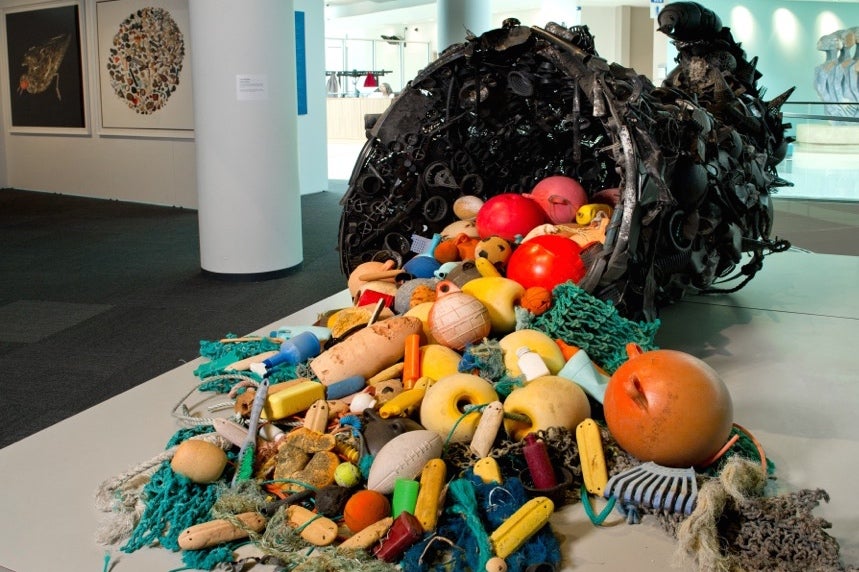A recent New York Times article revealed findings from a study featured in Science showing that plastic levels are on the rise. The study estimates that eight million metric tons of plastic waste enter the ocean every year. The news of plastic in our oceans is unfortunately not new, but this quantified numeric estimate is, and it is shocking.
Back in 2009, the Journal Philosophical Transactions: Biological Sciences published a special theme issue dedicated to this same topic: the study of plastic’s environmental effects. In the introduction, entitled “Our Plastic Age,” Richard C. Thompson et al. introduce the theme by examining plastic’s strengths (its fluidity, malleability, durability, diversity of byproducts, and versatility) and its conversely devastating weaknesses (its longevity, leaching chemicals, and inordinate impact on marine environments).
GYRE: The Plastic Ocean, an exhibit curated by Julie Decker, set out to capture this darker side of plastic visually and emotionally. It began with an expedition to Alaska’s coastline to study the plastic trash washing ashore in remote areas often assumed to be pristine.
Works like Pam Longobardi’s Bounty, Pilfered and Steve McPherson’s Object Series use found sea-plastic (our seemingly modern-day sea glass) to create three-dimensional installations. In The Entire Stomach Contents of ‘Shed Bird,’ Susan Middleton photographed the plastic that led this albatross to meet his early death. In Pack Dogs, Cynthia Minet creates a brightly lit team of plastic dogs made from postconsumer plastics and in Blue Cord, Sonya Kelliher-Combs uses found plastic to examine man’s footprint, offering an indigenous perspective on communal recycling to show how everything, including plastic, is saved and reused in her native Alaska.
Something the exhibit drives home unequivocally is plastic’s ability to outlive us all. In “Accumulation and Fragmentation of Plastic Debris in Global Environments,” David K. A. Barnes et al. emphasize its reach:
Plastics have transformed the surface of the planet, far beyond areas of human population density—fragments of all sizes are ubiquitous in soils to lake beds, from remote Antarctic island shores to tropical seabeds. Plastics turn up in bird nests, are worn by hermit crabs instead of shells and are present in turtle stomachs. Humans generate considerable amounts of waste and the quantities are increasing as standards of living and the population increase.
Decker and the exhibition’s artists walk a fine line between foretelling an impending and unstoppable doomsday and extending a hand to viewers to pull them up off their seats and compel them to do more. GYRE opened at the Anchorage Museum in 2014 and moved to Atlanta’s David J. Sencer CDC Museum in January of 2015. Next up, it travels to Los Angeles’ USC Fisher Museum of Art and will likely continue to travel onward from there, as the exhibit is taking on a life of its own.
Georgia State University and the David J. Sencer Museum of the Centers for Disease Control and Prevention sponsored a two-day symposium to run alongside GYRE. “The Plastic Gyre: Artists, Scientists, and Activists Respond” featured interdisciplinary panels discussing the environment, art, activism, and key scientific research and findings around plastic pollution. Hopefully these kinds of exhibits and events will move viewers beyond merely seeing and instead inspire active doing.







